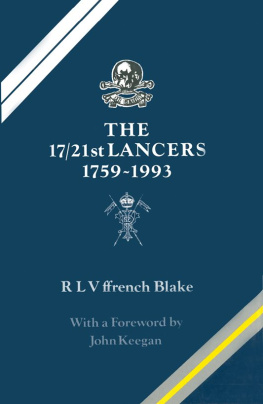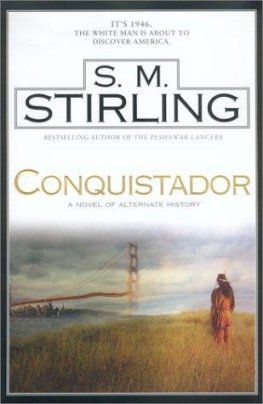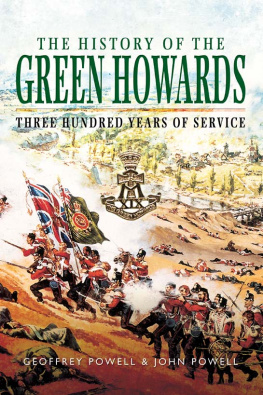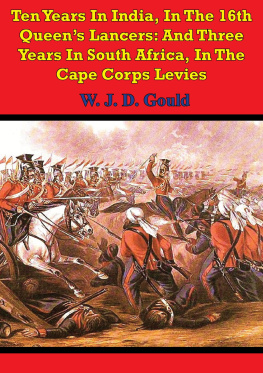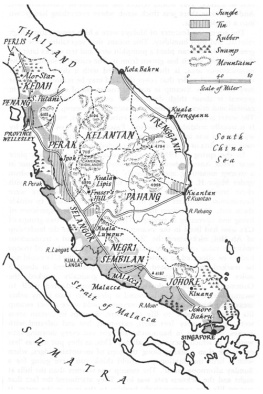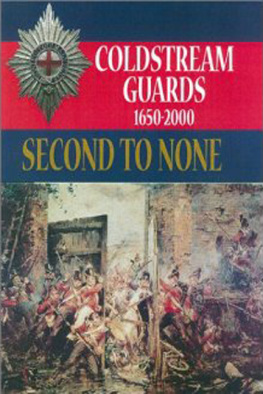R. L. V. Ffrench Blake - The 17/21st Lancers, 1759–1993
Here you can read online R. L. V. Ffrench Blake - The 17/21st Lancers, 1759–1993 full text of the book (entire story) in english for free. Download pdf and epub, get meaning, cover and reviews about this ebook. year: 1993, publisher: Pen & Sword Books, genre: Art. Description of the work, (preface) as well as reviews are available. Best literature library LitArk.com created for fans of good reading and offers a wide selection of genres:
Romance novel
Science fiction
Adventure
Detective
Science
History
Home and family
Prose
Art
Politics
Computer
Non-fiction
Religion
Business
Children
Humor
Choose a favorite category and find really read worthwhile books. Enjoy immersion in the world of imagination, feel the emotions of the characters or learn something new for yourself, make an fascinating discovery.
- Book:The 17/21st Lancers, 1759–1993
- Author:
- Publisher:Pen & Sword Books
- Genre:
- Year:1993
- Rating:4 / 5
- Favourites:Add to favourites
- Your mark:
- 80
- 1
- 2
- 3
- 4
- 5
The 17/21st Lancers, 1759–1993: summary, description and annotation
We offer to read an annotation, description, summary or preface (depends on what the author of the book "The 17/21st Lancers, 1759–1993" wrote himself). If you haven't found the necessary information about the book — write in the comments, we will try to find it.
The 17/21st Lancers, 1759–1993 — read online for free the complete book (whole text) full work
Below is the text of the book, divided by pages. System saving the place of the last page read, allows you to conveniently read the book "The 17/21st Lancers, 1759–1993" online for free, without having to search again every time where you left off. Put a bookmark, and you can go to the page where you finished reading at any time.
Font size:
Interval:
Bookmark:
by
R.L.V. FFRENCH BLAKE

LEO COOPER
LONDON
First published in Great Britain 1968
by Hamish Hamilton Ltd
Republished in this revised edition 1993
by Leo Cooper
190 Shaftesbury Avenue, London, WC2H 8JL
an imprint of Pen & Sword Books Ltd.,
47 Church Street, Barnsley, S70 2AS
Copyright 1968, 1993 R.L.V. ffrench Blake
A CIP catalogue record of this book is available from the British Library
ISBN 0 85052 272 2
Typeset by Yorkshire Web, Barnsley, in 10 point Plantin
Printed by Redwood Books,
Trowbridge, Wiltshire.
by John Keegan
The regiment is a peculiarly British institution. Other armies have regiments, some of great antiquity, but none bear the distinguishing marks that make the British regiment into the brotherhood of warriors that it is. The chief distinguishing mark is stability, conferred by the practice of enlistment by the individual in one regiment for the whole of his service. A second is territorial association, by which a regiment draws its members from the same region. A third is autonomy, a degree of self-government in choosing its members and regulating its internal affairs, including even succession to command. A fourth is individuality in dress, customs, drill and forms of address, which emphasise the difference between one regiment and another.
There are other characteristics but these are the most important. They have been acquired gradually. Officers, until the abolition of purchase in 1871, exchanged between regiments quite frequently, while cavalry regiments associated themselves with recruiting areas only after the Second World War. From early times, however, regimental individuality was pronounced, so much so that the evolution of the regiment into its distinctive modern form may be said to have been a natural development. The British regiment is an organic, not a statutory organisation, which has grown into what it is, deriving its nature from a variety of origins and influences.
The history of the 17th/21st Lancers exemplifies the pattern of regimental development in all its complexity. Under its present title it dates from the amalgamations of historic cavalry regiments in 1922. The 17th Lancers had originally been Light Dragoons, raised for the Seven Years War in 1759 and transformed into lancers after Waterloo. The 21st had had several incarnations, regiments of Light Dragoons with that number having been raised and disbanded during the Seven Years War, the American War of Independence and the Napoleonic Wars. Most recently the 21st had begun as a regiment of the Honourable East India Company, the 3rd Bengal European Cavalry. It was brought on to the British establishment at the Companys dissolution, after the end of the Mutiny, and was entitled Light Dragoons and Hussars before becoming Lancers in 1897. As a former Indian regiment it brought with it traces of the French grey and silver uniform of the Companys cavalry, which derived in turn from that of Louis XVs hussars, introduced into the sub-continent by the French adventurers who were Clives opponents in the struggle for control of the Moghul empire. That was not its only connection with the Moghul past. The title of Empress of India assumed by Queen Victoria, which she used in honouring the 21st for its distinction in the battle of Omdurman, was a revival of that borne by the Moghuls. Since the Moghuls claimed descent from Genghis Khan, the 21st preserve an association with the most ferocious light horsemen the world has ever known.
Being light horse, both the 17th and 21st have an extensive history of participation in imperial campaigns far from home, to which heavy cavalry was unsuited. America figures in their past to an unusual degree. The 17th saw out much of the American War of Independence. It also took part in the expedition to the River Plate of 18067, as did the 21st in its second incarnation, a strange episode from which Britains troubled relationship with Argentina dates. The 17th campaigned widely in India, during the Companys wars of conquest and pacification in the early nineteenth century, and returned for the Mutiny, in which the 3rd Bengal European Cavalry was raised. Both regiments were to fight in Africa, against the Zulus, Sudanese and Boers; in the second Sudanese campaign the 21st mounted one of the most famous and one of the last decisive charges delivered by British cavalry.
The regiment which came into existence in 1922 had, therefore, a heritage of service perhaps more varied than that of any other in the cavalry of the line. It also had outstanding distinctions, notably from the Crimea where it had charged in the Light Brigade at Balaclava. Its imperial involvement had kept it outside Europe during the Napoleonic Wars, while the nature of the First World War had deprived it of the chance to operate in its traditional role on those battlefields. In the Second World War, however, it was to win new and great distinction, particularly in the bitter battles around the Kasserine Pass in Tunisia in 1943, and then in the long struggle for Italy on terrain so menacing to armoured units.
The regiments last commitment before amalgamation was in Operation Granby in the Gulf War, where a detachment took part in what will come to be recognised as the most perfectly executed offensive in the history of armoured warfare. Now it is to amalgamate with the 16th/5th Lancers, with which it fought in Tunisia. It brings to the amalgamation not only its ancestral honours and its imperial traditions but also its distinctive regimental character. It is a strongly family regiment, in which many men with the same name have served over several generations. It has become firmly territorial, with its roots in the central shires. It has highly distinctive customs and unique peculiarities, notably the most widely recognised cap badge in the army. It is, above all, a happy regiment, not only a brotherhood of warriors but a genuine community of past and present members and of their kith and kin. The 17th/21st Lancers exemplifies the regimental system at its best. Its friends will wish it a splendid new future in its incarnation as the Queens Royal Lancers.
WITH THE impending amalgamation of the Regiment with the 16th/5th Royal Lancers, the title of 17th/21st Lancers will disappear for ever from the Army List. It has therefore been thought fitting to bring this short history up to date by adding one more chapter to cover the years since 1963. The book originally appeared as one of the Famous Regiments series published by Leo Cooper.
In writing this history of the Regiment, in which four generations of my family have had the honour to serve, I found myself faced with several problems. First, the need to condense some quarter-million words by previous historians, into the thirty thousand permitted by the publishers; secondly, the need to balance between chronicles of movements of troops and squadrons, and descriptions of the men who led them and fought in them; thirdly, my dislike of histories which describe operations in a campaign without enabling the reader to visualize how and where these actions fit into the campaign as a whole; lastly, my desire to include some account of the development of the cavalry as a whole during the period covered by the book. It is for this reason that I have included much detail about mechanization and early efforts at tank tactics.
In the 17th/21st we are lamentably short of documents our regimental papers were repeatedly sunk at sea; we have no Rifleman Harris; we are short of local colour; many of our campaigns were fought in remote corners of the globe, seldom in Europe; first-hand accounts are rare.
Font size:
Interval:
Bookmark:
Similar books «The 17/21st Lancers, 1759–1993»
Look at similar books to The 17/21st Lancers, 1759–1993. We have selected literature similar in name and meaning in the hope of providing readers with more options to find new, interesting, not yet read works.
Discussion, reviews of the book The 17/21st Lancers, 1759–1993 and just readers' own opinions. Leave your comments, write what you think about the work, its meaning or the main characters. Specify what exactly you liked and what you didn't like, and why you think so.

